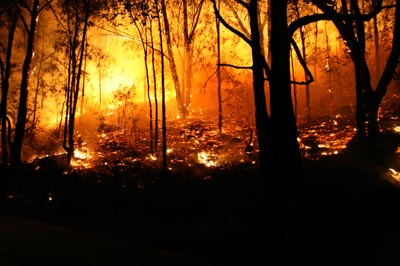
A team of researchers in the US has worked out a scheme for optimal control of complex systems, where one event can lead to another. The researchers have studied how best to intervene in so-called self-organized critical systems, which are constantly poised on the brink of a cascade, so as to suppress or manage “avalanches” and propagating crises. The approach might potentially be applied to real landslides and avalanches, forest fires and perhaps even economic crises.
Risk assessment
Sometimes the best way to prevent a big crisis is to bring on a small one. Large snow avalanches can be avoided by using explosives to trigger smaller ones and the same strategy has been discussed for earthquake control. But it might be risky and potentially costly to trigger even little cascade events in complex systems such as these.
To find the best balance between avoiding catastrophic cascades and inducing small ones, Pierre-André Noël, Charles D Brummitt and Raissa M D’Souza from the University of California, Davis in the US, considered as their model the standard example of self-organized criticality (SOC) – the sand pile. A pile of sand, to which grains are slowly being added at the apex, is always prone to avalanches of any size – from just a few tumbling grains to a landslide of the whole pile surface – because of “chain reactions” in grain collisions. There is no telling at the outset how big an avalanche might be. But the probability of it occuring decreases – in a mathematical relationship know as a “power law” – as the event gets bigger. That is the signature of SOC and it has been seen in models of earthquakes, forest fires, ecosystem collapses and economic fluctuations.
Whether such behaviour applies in the corresponding real-world examples remains controversial. Systems engineer John Doyle of the California Institute of Technology says that power laws in such cases are generally illusory, caused by poor data analysis. “There are no examples in nature or technology that are plausibly examples of SOC,” he says.
All the same, SOC and sand piles might offer at least an analogue of how cascades and failures can propagate through complex systems consisting of many interacting components – particularly when these components are joined into branching networks of interaction, such as power grids and ecosystems.
Strain release
As power blackouts such as those that struck the eastern seaboard of North America in 2003 showed, major cascades in these systems can be hugely costly and even fatal. One way to avoid such catastrophes is to release any build-up of “strain” in the system before it develops into a big cascade by intentionally triggering a smaller one. But that might be costly, both in terms of the amount of intervention needed and the consequences of the smaller events. Given a particular “cost function” that specifies the cost of an event of a particular size, says Noël, “there is an optimal level of control – to avoid catastrophic failures, say – that does not push too hard”.
To show this in a sand pile, the researchers developed a model in which the grains are linked into interaction networks that specify which of them will affect others. They considered that all cascades have a cost proportional to their size, and calculated the fraction of forced cascades (denoted μ) that minimizes the total cost. In their model, the only means a controller has of inducing or suppressing cascades is to specify where in the network a new grain lands – akin to dropping snow or starting a forest fire in a particular location.
Noël and colleagues found that, in general, there is an optimal value of μ between 0 (no cascades at all) and 1 (all cascades are triggered). Trying too hard to suppress cascades (making μ too small) can be counterproductive, pushing the system towards the “critical” state in which a major cascade is likely.
Real-world problems
Alessandro Vespignani, a specialist on complex networks at Indiana University in Bloomington, says that among those working on self-organized criticality, “this phenomenology was already known and not surprising”. However, he adds that the new work shows how to express the problem in formal terms, which could point the way to more nuanced theoretical treatments.
Noël agrees that the general approach of “strain relief” is already well understood. “Our contribution is to identify the general mechanism behind this type of behaviour, and provide a way to track it analytically,” he says.
But it is still unclear how this quantitative strategy could be implemented in real-world systems, according to Vespignani. Frank Schweitzer, a specialist in complex social systems at the Swiss Federal Institute of Technology (ETH) in Zurich, shares that concern. “In real-world systems, it’s often impossible to control where a cascade starts,” he says. “It’s often easier to control connectivity or node capacity, neither of which is touched in the proposed model.” He thinks that some of the more sophisticated strategies already employed, such as “load-shedding” in power grids, will remain preferable.
“It’s difficult to extrapolate to real-world scenarios because they’re so much more rich than this simple model,” Noël admits. “But the model begins to define what to measure and which mechanisms matter.”
The research is published in Physical Review Letters.



